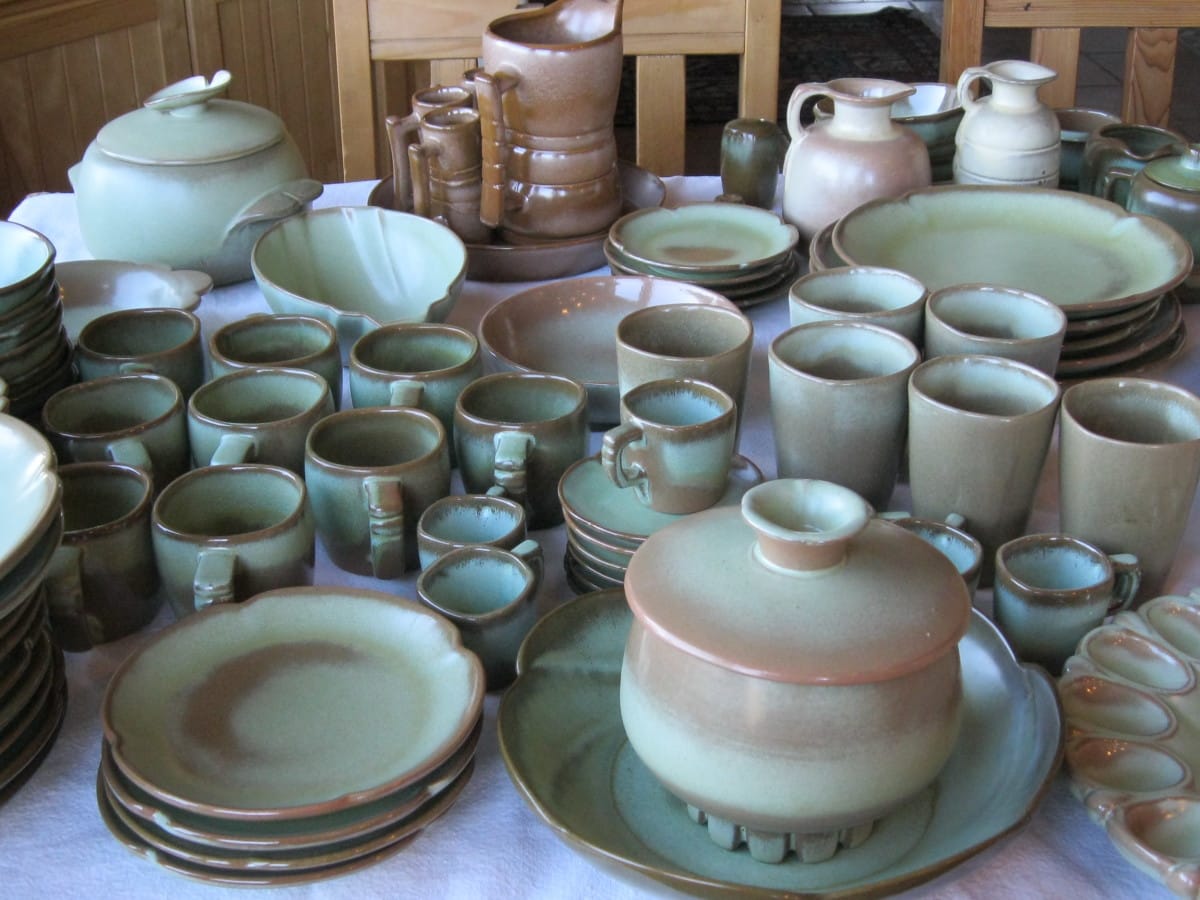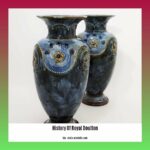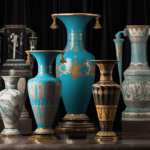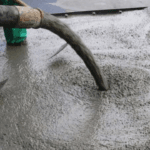Hey there, curious cat! Grab a comfy spot as we delve into the captivating world of Frankoma Pottery. This American pottery powerhouse boasts a rich and fascinating history, from its humble beginnings to its evolution into a beloved brand. Join us as we unearth the story of Frankoma, exploring its origins, its impact on American craftsmanship, and its enduring appeal to collectors and art enthusiasts alike.
History of Frankoma Pottery
Frankoma Pottery’s story is one of resilience and artistic passion, beginning during the tumultuous era of the Great Depression. In 1933, John Frank, a ceramics professor at the University of Oklahoma, envisioned creating beautiful and durable pottery using local resources. Combining his last name, “Frank,” with “Oklahoma,” he coined the name “Frankoma.”
Their initial workshop was established in Norman, Oklahoma. However, a fire in 1938 prompted a relocation to Sapulpa. This move proved serendipitous, as they discovered the distinctive brick-red clay that would become synonymous with Frankoma Pottery. This unique clay imbued their pottery with a warm, earthy aesthetic that captivated the hearts of many.
John and his wife, Grace Lee Frank, a talented artist in her own right, managed the company together until 1973. Grace even launched a second pottery line called Gracetone, characterized by its delicate designs and unique style.
Frankoma’s journey, like many businesses, was marked by both triumphs and tribulations. They faced numerous challenges, including another devastating fire in 1984 that necessitated rebuilding. Sadly, financial difficulties led to bankruptcy in 1990.
However, Frankoma’s story is more than just pottery; it’s intertwined with the history of Oklahoma. Despite changing hands and even facing closure in 2010, the company’s significance was recognized. In 2012, the factory and its distinctive molds were acquired, breathing new life into the brand. Today, Frankoma Pottery continues to be crafted in Oklahoma, keeping its legacy alive.
But what exactly makes Frankoma so special? The name itself is a tribute to its roots, a constant reminder of its humble beginnings. Their ability to bounce back from adversity speaks volumes about the quality and appeal of their work. Each piece of Frankoma pottery embodies the spirit of perseverance, creativity, and the beauty of handcrafted artistry.
A testament to its cultural significance, a 2012 exhibition titled “Oklahoma Clay: Frankoma Pottery” showcased how their work reflects the essence of Oklahoma’s past. Frankoma pottery, much like a time capsule, carries within it the spirit of a bygone era.
So, the next time you encounter a piece of Frankoma pottery, take a moment to appreciate its story. You’re not simply holding a vase or a plate; you’re holding a tangible piece of history.
Is Frankoma Pottery Worth Anything?
Stumbling upon Frankoma pottery, whether in a dusty attic or an antique shop, often sparks a common question: “Is this stuff worth anything?” The answer is, quite possibly! Frankoma pottery possesses a unique allure and rich history that makes it highly collectible. Let’s delve into the world of Frankoma and explore the factors that influence its value.
Think Like an Antique Roadshow Appraiser
Just like on those captivating antique shows, several key elements contribute to a piece’s worth. It’s not merely about the “Frankoma” stamp on the bottom; it’s about deciphering the clues that reveal its value.
1. Older the Better (Usually!)
As with many antiques, age plays a significant role in Frankoma’s value. Pieces crafted in its early years are often highly sought after by collectors. Like a fine wine, the older it gets, the more desirable and potentially valuable it becomes.
2. Color Me Intrigued
While Frankoma is celebrated for its earthy tones, certain colors are rarer than others. Green and gold pieces, for instance, stand out and command a premium among collectors due to their scarcity.
3. Local Materials = Local Love
Frankoma’s use of locally-sourced clay adds to its appeal. Pieces crafted with a higher percentage of this distinctive red and white clay are highly prized by those who appreciate the authenticity and connection to Oklahoma’s resources.
4. Rarity Rules the Roost
Limited-edition items always generate excitement, and Frankoma is no exception. Unusual patterns, rare designs, or pieces that deviate from the norm are more likely to pique collectors’ interest and command higher prices.
5. Southwestern Style Points
Frankoma often drew inspiration from its Oklahoma roots, incorporating Southwestern patterns and motifs into its designs. Wagon wheels, Native American-inspired designs, and desert landscapes hold particular appeal for collectors drawn to this unique aesthetic and cultural significance.
So, What’s the Magic Number?
Putting an exact price tag on Frankoma pottery without examining the specific piece is challenging. However, most vintage Frankoma pieces typically range in value from $5 to $400, depending on a variety of factors.
The Thrill of the Hunt
Ultimately, the value of Frankoma pottery extends beyond monetary worth. It’s about the sentimental value, the thrill of the hunt, and the joy it brings to collectors. Discovering hidden treasures and appreciating the artistry and history behind each piece is part of Frankoma’s allure.
When Did They Stop Making Frankoma Pottery?
For those captivated by Frankoma Pottery, a common question arises: When did they cease production? Sadly, the factory closed its doors in 2010 due to financial difficulties, marking the end of an era for this iconic American pottery maker.
In 2011, a large auction was held to settle debts, with everything from equipment and leftover pottery to the Frankoma name itself up for sale. This event signified the official closure of the original Frankoma Pottery company.
However, the spirit of Frankoma didn’t fade entirely. In 2012, a licensing partnership revived the brand, albeit in a smaller capacity. Limited production of artware commenced, primarily sold online. The popularity of these newer pieces demonstrates the enduring appeal of the Frankoma style.
While the factory may no longer be bustling, Frankoma pottery continues to be cherished by collectors. Owning a piece of Frankoma is about more than just the object itself; it’s about owning a tangible piece of history. Each piece, with its distinctive designs and hand-crafted quality, tells a story of Oklahoma’s heritage and the artistry of a bygone era. So, while the original company may be gone, Frankoma’s legacy lives on in every piece we find and cherish.
What Do the Numbers Mean on Frankoma Pottery?
Those mysterious numbers on the bottom of your Frankoma pottery? They’re not random! Often referred to as “mold numbers,” they offer glimpses into your piece’s past.
Think of each mold as a cookie cutter for pottery. Every time a specific shape was needed, like a vase or a mug, clay was pressed into a mold. The number on the bottom identifies which “cookie cutter” was used.
But why is this significant? These numbers help us piece together the story of your pottery.
Firstly, certain molds were used during specific periods. The mold number can provide a rough estimate of when your piece was made, acting as a miniature time capsule.
Secondly, mold numbers can reveal the popularity of a particular design. A mold used for an extended period likely produced more pieces than one used only briefly.
Intriguingly, even seemingly identical pieces might have slightly different mold numbers, indicating subtle design changes or variations in glaze over time.
It’s important to remember that mold numbers aren’t direct indicators of value. Numerous factors, such as condition, rarity, and desirability, influence a Frankoma piece’s worth.
You might encounter Frankoma pieces without any numbers, especially older or smaller items. These are like rare, first-edition books – special even without ISBN numbers.
So, the next time you admire your Frankoma pottery, take a peek at the numbers on the bottom. They’re whispers from the past, narrating your pottery’s journey from the mold to your hands.
Is Frankoma Pottery Hand Made?
Absolutely! Frankoma pottery is more than just made in Oklahoma – it’s crafted there, each piece meticulously shaped and molded by skilled artisans. And the clay? It’s the real deal, sourced directly from Oklahoma, giving Frankoma its distinctive character.
That warm, earthy, terra cotta essence? That’s the Oklahoma clay shining through. The glazes, too, seem to sing on this unique clay, creating vibrant, eye-catching colors. This level of character simply can’t be replicated by mass production.
Each piece emerging from the Frankoma studio is unique, bearing the mark of the artisan’s hand. You can practically feel the history and tradition baked into every mug, vase, and plate. No wonder Frankoma pottery is so highly sought after by collectors! It’s not just pottery; it’s a tangible piece of Oklahoma history, and that’s something you simply can’t mass-produce.
Key Takeaways:
- Frankoma pottery is handmade in Oklahoma, using locally sourced clay.
- Its unique style and handcrafted nature make it highly sought after by collectors.
- Collectors are drawn to its strong connection to Oklahoma’s rich history and artistic tradition.
How Do I Date a Frankoma?
You’ve acquired a piece of Frankoma pottery and are curious about its history. Whether it’s a cherished heirloom, a thrift store discovery, or the start of a collection, determining its age can be an engaging puzzle.
What Makes Frankoma Special?
Frankoma pottery, produced in Oklahoma from 1933 to 2010, holds a special place in the hearts of collectors. Its unique style, handcrafted nature, and use of local materials make each piece a testament to American craftsmanship.
Clues to Crack the Code:
Dating Frankoma pottery requires a bit of detective work, as there’s no definitive guidebook. However, certain telltale signs can help you estimate a piece’s age.
1. The Clay Tells a Tale:
- Before 1954: Frankoma used “Ada Clay,” which fired to a light beige, almost like a creamy coffee with extra milk.
- After 1954: They switched to “Sapulpa Clay,” a reddish-pink hue reminiscent of a desert sunset.
Examining the base of your piece and observing the clay color can provide a significant clue about its age.
2. Marks and Numbers, Oh My!:
Most Frankoma pieces are marked on the bottom with “Frankoma,” often accompanied by a mold number, like a secret code.
- Early Birds: The very first Frankoma pieces, especially smaller items, might lack these mold numbers.
3. A Rainbow of Glazes (But Don’t Be Fooled):
Frankoma is renowned for its stunning glazes, particularly “Desert Gold” and “Prairie Green.” However, while these colors are beautiful, the price tag isn’t always about the glaze.
- Clay is King: The type of clay used is actually more important when determining a piece’s worth.
4. Designs Inspired by the West:
Frankoma often drew inspiration from the Southwest, incorporating elements such as:
- Native American designs: Intricate masks or patterns influenced by pottery traditions.
- Cowboy Cool: Boot-shaped vases or other motifs that evoke the “Wild West.”
- Rustic Charm: Dinnerware with a simple, down-to-earth feel was another Frankoma staple.
These design clues can help narrow down the era your piece might be from.
5. So, What’s It Worth?
The value of Frankoma pottery can vary greatly, influenced by factors like:
- Rarity: The rarer a piece, the more it might be worth.
- Condition: Is it in pristine condition, or do chips and scratches add to its character?
- Special Editions: Frankoma released limited-edition pieces that are highly sought after by collectors.
Frankoma: A Never-Ending Story
Dating Frankoma is an adventure, a puzzle waiting to be solved. Even experts are continually learning new things about this beloved pottery. The more you explore, the more you’ll appreciate the artistry, history, and craftsmanship woven into each piece.
What is the Most Sought After Vintage Pottery?
We’ve explored what makes vintage pottery special, but now let’s uncover the secrets of valuable pottery.
Not every piece from your grandmother’s attic is a gold mine. Some pieces are simply more sought after than others, possessing qualities that make them stand out.
Rarity, as with any collectible, significantly impacts value. Imagine a limited-edition comic book – the fewer copies exist, the more valuable it becomes. The same principle applies to pottery. If a piece was produced in limited quantities or is no longer made, it could be something special.
Now, picture that comic book with a torn cover. Not as appealing, right? Condition is crucial with pottery. Chips, cracks, or any damage can diminish its value. A well-preserved piece, however, is a collector’s dream.
Age generally plays a significant role in an antique’s worth, and pottery is no exception. Older pieces are often more valuable due to their rarity and historical significance.
But age alone isn’t enough – it must be beautiful! The design of a piece is paramount. Unique patterns, intricate details, and artistic flourishes are what make collectors take notice.
Finally, there’s provenance, or a piece’s history. Imagine knowing your pottery belonged to a famous artist or was displayed in a museum! That kind of backstory adds a whole other layer of value, like a certificate of authenticity for your treasure.
So, what pottery should you look for? Pieces from renowned manufacturers like Meissen, Wedgwood, Royal Doulton, and Limoges are always in high demand. However, don’t be afraid to trust your instincts. If you discover a piece you love, with a unique design and in excellent condition, it could be worth exploring further.
Where Can I Sell My Frankoma Pottery?
If you’re looking to sell your Frankoma pottery, you have several options, whether you’re parting with a single piece or a whole collection.
The World of Online Selling
The internet has revolutionized buying and selling, including vintage pottery. Consider these online platforms:
- eBay: This online marketplace is a great option for reaching a large audience, some of whom may be specifically searching for Frankoma.
- Etsy: Known for handmade and vintage items, Etsy is ideal if your Frankoma pieces have a vintage aesthetic.
- Live Auctioneers: For rare or more valuable pieces, Live Auctioneers allows you to auction items live or on a timer.
- 1stDibs: This online marketplace specializes in high-end and collectible items, making it a suitable platform for showcasing special Frankoma pieces.
Connecting with Fellow Frankoma Fans
Sometimes, the best buyers are fellow collectors who appreciate the value and history of your pieces.
- Social Media: Join Facebook groups, Instagram pages, and online forums dedicated to Frankoma pottery. Share photos of your pieces, connect with enthusiasts, and you might find a buyer.
- Frankoma Events: Attend local or regional Frankoma events to connect with collectors and immerse yourself in the Frankoma community.
Become the Frankoma Expert
Confidence in a seller’s knowledge can influence buyers.
- Details Matter: Provide detailed descriptions of your pottery, including clay type, color, size, and any unique markings or etchings.
- Share Your Knowledge: Incorporate your knowledge of Frankoma’s history, design styles, or craftsmanship into your descriptions or conversations with potential buyers.
- Go to the Source: Consider reaching out to Frankoma Pottery directly. They might have suggestions, leads, or be able to authenticate your items, adding value.
Thinking Outside the (Pottery) Box
Don’t limit yourself to online platforms and collector groups.
- Antique Shows: Local antique shows and flea markets can be treasure troves for vintage finds.
- Appraisals: A professional appraisal helps determine a fair selling price and adds credibility to your items.
- Niche Marketplaces: Explore specialized online marketplaces dedicated to vintage and collectible pottery.
Remember…
Selling your Frankoma pottery is a process, and finding the right buyer might take time. Be patient, explore different avenues, and enjoy connecting with fellow enthusiasts as you find new homes for these unique and cherished pieces.
How Do I Know if My Pottery is Valuable?
Determining the value of your pottery involves a bit of detective work. It’s about examining various factors, much like piecing together a puzzle.
Condition is paramount. Pottery in pristine condition – free of chips, cracks, or repairs – is more desirable and, therefore, more valuable.
Rarity also significantly influences value. Just like a limited-edition item, a rare piece of pottery is likely to be worth more to collectors.
Authenticity is crucial. Verifying that your pottery is the real deal is essential. Look for maker’s marks, signatures, or factory stamps that can help trace its origins. Consulting with an expert or obtaining an appraisal can provide valuable insight.
Aesthetics also play a role. The piece’s shape, color palette, and design intricacy contribute to its overall appeal and can influence its value.
Desirability, influenced by trends, historical significance, and connections to famous artists or studios, can impact a piece’s market value.
Finally, provenance, or the pottery’s history, can significantly increase its worth.
Additional Tips:
- Unusual Features: Quirky shapes, unexpected colors, or patterns that deviate from the norm often indicate rarity and can increase value.
- Research is Key: Delving into the history, cultural context, and production techniques associated with your pottery can provide valuable insights.
- Seek Expert Opinions: Online resources are helpful, but consulting with a professional appraiser or antiques expert can offer specialized knowledge.
Determining the value of pottery is not an exact science. It involves considering various factors and understanding the art form’s nuances. So, embrace the detective work, do your research, and you might just uncover a hidden treasure!
How to Tell the Age of Frankoma Pottery?
Dating Frankoma pottery is like solving a mystery, using clues to estimate its age. While not always an exact science, with practice, you can become adept at deciphering the signs.
1. Color Clues: A Rainbow of History
Frankoma’s color palette evolved over time, offering hints about a piece’s age.
- Earthy Elegance: Early Frankoma (pre-1950s) often features natural clay colors – browns, tans, and creams.
- Green with Envy: Green or gold Frankoma, especially dinnerware, vases, or lamps, is rare and highly sought after. These colors were produced for a limited time in the 1950s and 1960s.
- A Spectrum of Style: Over time, Frankoma experimented with a broader range of colors, including blues, yellows, and even pinks, often indicating later production decades.
2. Material Matters: Feeling the Difference
The feel of the clay can provide clues about a piece’s age.
- Rustic Charm: Early Frankoma pieces, crafted with a higher percentage of red clay, have a rustic and slightly rougher texture.
- Smooth Operator: As Frankoma incorporated more white clay, later pieces tend to have a smoother, more refined feel.
3. Motif Magic: Decoding the Designs
Frankoma’s hand-carved designs, or motifs, offer hints about a piece’s age.
- Geometric Beginnings: Early Frankoma often features simpler geometric patterns – clean lines, repeating shapes, and a focus on symmetry.
- Nature’s Embrace: Later Frankoma pieces often depict more intricate nature-inspired patterns – leaves, flowers, animals, and landscapes.
4. Mold Numbers: Cracking the Code (Sometimes!)
The mold number on the bottom of a piece can sometimes provide a general idea of its age.
- Lower Numbers, Older Pieces?: Lower mold numbers often correspond to earlier production periods, but keep in mind that Frankoma’s use of mold numbers wasn’t always consistent.
5. Wear and Tear: Marks of Time (and Character!)
While chips or cracks can affect value, they can also be signs of a well-loved and well-used piece.
A Few More Things to Keep in Mind:
- Ongoing Research: New information about Frankoma pottery and dating techniques is constantly emerging. Stay connected with collector communities and resources.
- Expert Opinions: Consult experienced Frankoma collectors or antique appraisers for expert assessments.
- Enjoy the Journey! Dating Frankoma pottery is about the thrill of discovery and learning about its history.
Is Frankoma Pottery Always Marked?
While finding a “Frankoma” stamp can delight collectors, not every piece will have one.
Imagine trying to identify clothes in your closet based solely on tags. Some might be missing, faded, or gone! It’s the same with older Frankoma, particularly pre-1950s pieces. Marking every piece wasn’t always standard practice.
However, the absence of a “Frankoma” stamp doesn’t necessarily mean a piece isn’t authentic. Look for other telltale signs:
- Frankoma Clay: Most Frankoma pottery features a blend of red and white clay, giving it a reddish-brown hue.
- Glaze Characteristics: Frankoma is known for its smooth, glassy glaze, often clear or colorful, and sometimes with a “crackled” or “crazed” appearance.
- Distinctive Style: Frankoma often exhibits simple, elegant designs, bold colors, and geometric shapes.
Unmarked vs. Marked: The Value Factor
Marked Frankoma pottery tends to be worth more than unmarked pieces due to easier authentication.
However, factors like age, condition, and rarity can influence an unmarked piece’s value. A well-preserved, unusual piece from Frankoma’s early years could still be a treasure.
When in Doubt, Ask the Experts!
If you’re unsure about a piece, consult antique appraisers or experienced collectors for expert opinions.
The World of Frankoma: Always Something New to Discover
Research into Frankoma pottery is ongoing, continually uncovering new information about markings, glazes, and production techniques.
Dive into the world of Frankoma with an open mind, embrace the thrill of the hunt, and remember – even without a mark, every piece has a story to tell.
Curious About Other Iconic Brands and Their Histories?
Frankoma Pottery’s story is just one example of the fascinating histories behind everyday objects. If you enjoyed this journey, you might be interested in exploring the stories of other brands:
- Curious about the history of Folgers coffee and how it became so beloved? Here’s the story behind the legendary brand.
- The fascinating history of Gideons International is a testament to how far faith and a good deed can go.
- Uncover the rich tapestry of Gruene, Texas, a historical gem that has witnessed centuries of change and preserved its unique charm.















